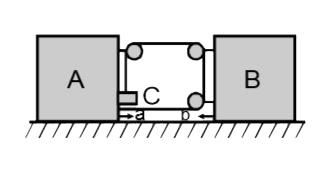A railway carriage moves over a straight track with acceleration a. Passenger in the carriage drops a stone. What is the acceleration of the stone w.r.t. the carriage and the earth?
To solve the problem, we need to determine the acceleration of the stone with respect to both the railway carriage and the Earth. Let's break it down step by step.
Step 1: Understand the scenario
The railway carriage is moving with an acceleration a along a straight track. When a passenger drops a stone, it will experience two accelerations: one due to gravity and one due to the motion of the carriage.
Hint: Identify the forces acting on the stone once it is dropped.
Step 2: Analyze the acceleration of the stone with respect to the Earth
When the stone is dropped, it is influenced by gravity. The acceleration due to gravity is denoted as g and acts downward (negative y-direction). Therefore, the acceleration of the stone with respect to the Earth is:
→astone, Earth=−g^j
Hint: Remember that the stone is in free fall once it is dropped, so only gravity affects its vertical motion.
Step 3: Analyze the acceleration of the stone with respect to the carriage
From the perspective of the carriage, the stone will also have a horizontal component of acceleration equal to that of the carriage, which is a in the positive x-direction. Thus, the acceleration of the stone with respect to the carriage is:
→astone, carriage=a^i−g^j
Hint: Consider the frame of reference of the carriage, where it appears that the stone has both horizontal and vertical accelerations.
Step 4: Calculate the magnitude of the acceleration of the stone with respect to the carriage
To find the magnitude of the resultant acceleration vector of the stone with respect to the carriage, we can use the Pythagorean theorem:
|→astone, carriage|=√a2+g2
Hint: Use the Pythagorean theorem to find the magnitude of a vector that has both horizontal and vertical components.
Summary of Results
1. The acceleration of the stone with respect to the Earth is:
→astone, Earth=−g^j
2. The acceleration of the stone with respect to the carriage is:
→astone, carriage=a^i−g^j
and its magnitude is:
|→astone, carriage|=√a2+g2
The railway carriage is moving with an acceleration a along a straight track. When a passenger drops a stone, it will experience two accelerations: one due to gravity and one due to the motion of the carriage.
When the stone is dropped, it is influenced by gravity. The acceleration due to gravity is denoted as g and acts downward (negative y-direction). Therefore, the acceleration of the stone with respect to the Earth is:
→astone, Earth=−g^j
From the perspective of the carriage, the stone will also have a horizontal component of acceleration equal to that of the carriage, which is a in the positive x-direction. Thus, the acceleration of the stone with respect to the carriage is:
→astone, carriage=a^i−g^j
To find the magnitude of the resultant acceleration vector of the stone with respect to the carriage, we can use the Pythagorean theorem:
|→astone, carriage|=√a2+g2
1. The acceleration of the stone with respect to the Earth is:
→astone, Earth=−g^j
2. The acceleration of the stone with respect to the carriage is:
→astone, carriage=a^i−g^j
and its magnitude is:
|→astone, carriage|=√a2+g2
Similar Questions
Knowledge Check
A bus moves over a straight level road with a constant acceleration a. A boy in the bus drops a ball out side. The acceleration of the ball w.r.t the bus and the earth are respectively
A√a2+g2,gBg,√a2+g2Ca,gDg,aA train is moving forward with a horizontal acceleration a. A man sitting in the train drops a coin on the floor of the train . The acceleration of the coin w.r.t man is
Ag downwardBa downwardC√a2+g2attan−1(ga) with horizontal in forward directionD√a2+g2attan−1(ga) with horizontal in backward directionA lift moves downwards with an acceleration a. A passenger in the lift drops a book. The acceleration of the book with respect to the floor of lift is-
(assume acceleration due to gravity = g)AgBaCg−aDg+a
A trains is moving on borizonatal rails with a uniform acceleration a.A passsenger sitting in a boffie drops a stone indide the boggie. What will be the acceleration of stone (i) w.r.t. boggie and (ii) w.r.t. the rails ?
View SolutionA stone is released from an elevator going up with an acceleration of g2. What is the acceleration of the stone just after release ?
View SolutionWhen a stone of mass m is falling on the Earth of mass M, find the acceleration of Earth if any?
View SolutionA stone of mass 50g is being rotated in a circle of radius 50cm with a uniform speed of 2m/s. What is the acceleration of the stone ?
View SolutionA stone is dropped from a balloon rising with acceleration a. The acceleration of the stone relative to the balloon is :
View Solution


